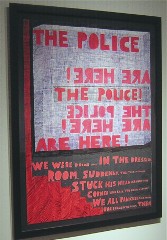
Anthony Campuzano, The Police are Here
Outsider obsession meets insider concepts in Anthony Campuzano’s energetic exhibit, The Police are Here, up at Fleisher-Ollman Gallery until March 4.
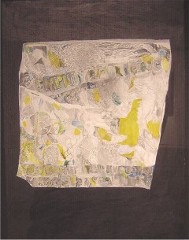
Campuzano, Employee Pricing
Campuzano, often appropriates obsessive stories in his word-driven art, and writes them out, word by word, in colliding color blocks of raving text that go straight back to the text insertions of outsider artists like William Hawkins and Sister Gertrude.
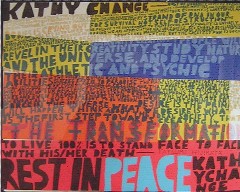
Campuzano, Portrait of Kathy Change
He adds a dose of political paranoia in this outing at Fleisher-Ollman, in pieces such as “Portrait of Kathy Change,” and “Portrait of Mae Brussel,” the latter a 12-panel piece filled from top to bottom with Lee Harvey Oswald’s final words. Mae Brussel, said gallerist John Ollman, is a talk-radio host with an Oswald obsession.
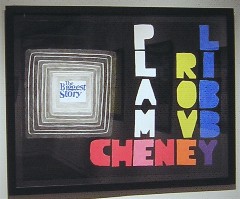
Campuzano, A Bigger Story
But it’s in “A Bigger Story” and some of the smaller pieces that Campuzano tips his hand. Suddenly we’re not only in the world of billboards and political cartoons, but we’re also in the land of conceptual art, of John Baldessari and Lawrence Weiner. In Campuzano’s work, the elegance of Baldessari’s and Weiner’s whippet-clean words collide with juicy visual environments. Campuzano’s words are overused and borrowed from a world filled with hyped-up language.
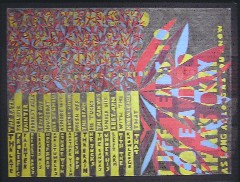
Campuzano, Freedom and the Guy
Campuzano crowds the language into his spaces until it explodes into some unexpected truth. I like the way he sees.
For other artblog comments on Campuzano, go here and here.
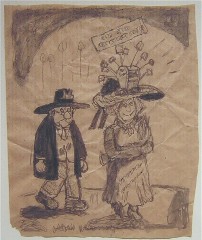
A James Castle cartoon appropriation
Also at Fleisher-Ollman, a series of drawings by outsider artist James Castle, whose widely admired soot-and-spit drawings also include these never-before-seen pieces, recently found by his family in a portfolio. The images are political cartoons appropriated probably from Herblock. Castle, who had an extraordinary memory for images, reproduced these from memory (how do we know this, I wonder somewhat belatedly). Since he was profoundly deaf and could not read, he replaced any words in the cartoons with scribbles.
Looking at them is not unlike looking at the New Yorker feature on the back page, cartoons for which readers are invited to supply the captions.
For me, the highlight was the stitched-together tiny sketch book, which contains smaller versions of some of the political cartoons on the wall. A swell facsimile, available for handling, is hanging next to the original.









